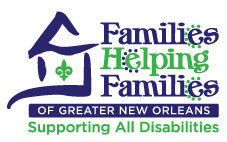The word “deaf-blindness” may seem as if a person cannot hear or see at all. The term actually describes a person who has some degree of loss in both vision and hearing. The amount of loss in either vision or hearing will vary from person to person.
Our nation’s special education law, the Individuals with Disabilities Education Act (IDEA), defines “deaf-blindness” as:
…concomitant [simultaneous] hearing and visual impairments, the combination of which causes such severe communication and other developmental and educational needs that they cannot be accommodated in special education programs solely for children with deafness or children with blindness. [§300.8(c)(2)]
The National Consortium on Deaf-Blindness observes that the “key feature of deaf-blindness is that the combination of losses limits access to auditory and visual information.” This can severely limit an individual’s natural opportunities to learn and communicate with others.
Finding Help for Children with Deaf-Blindness
Children birth to age 3 | Very young children (birth up to age 3) who are deaf-blind are typically eligible for early intervention services under the Infants and Toddlers with Disabilities program of IDEA (also called Part C). These services are extremely important to children with deaf-blindness and their families, for the services are designed to address the child’s developmental and learning needs. Parents are involved in deciding what services their child and family need to address the challenges of deaf-blindness. Services are either provided free of charge to families or on a sliding cost scale based on the family’s income.
- Part C – EarlySTEPS | EarlySteps provides services to families with infants and toddlers aged birth to three years (36 months) who have a medical condition likely to result in a developmental delay, or who have developmental delays. Children with delays in cognitive, motor, vision, hearing, communication, social-emotional or adaptive development may be eligible for services. EarlySteps services are designed to improve the family’s capacity to enhance their child’s development. These services are provided in the child’s natural environment, such as the child’s home, childcare or any other community setting typical for children aged birth to 3 years (36 months).
School-age children, including preschoolers | When children with deaf-blindness reach the age of 3, they transition into special education services under Part B of IDEA. Special education services are provided free through the public school system. Even if a child with deaf-blindness is not in school yet (for example, a four-year-old), the school system is still responsible for making sure that special education and related services are available to the child.
Because deaf-blindness causes severe communication and other developmental and educational needs, it is very important for children with deaf-blindness to receive special education and related services to address their individual needs. You can find out more about these services and how to access them by contacting the local elementary school in your area.
Families Helping Families of Greater New Orleans can assist you in navigating services through EarlySteps, the public school system, and provide you with additional supports if needed. Please call us for assistance at 504-888-9111, toll-free 1-800-766-7736, or by email at info@fhfofgno.org.
Additional Resources
Louisiana Deafblind Project | LSU Human Development Center – The Louisiana Deafblind Project for children and youth (LA-DBP) provides technical assistance and support to children and youth (birth to twenty- two years) in Louisiana with varying degrees of hearing and vision losses.
Louisiana Department of Health | Bureau of Family Health – Related Services | The Louisiana Commission for the Deaf (LCD) – The Louisiana Commission for the Deaf (LCD) provides people who are D/deaf, DeafBlind, hard of hearing, and those with speech disorders with programs and services to help them access and navigate the world around them.
Health Signs Center | Mission – To promote and advocate for the health, health equity, and health access for the deaf community, including persons who identify as DeafBlind, DeafDisabled, Hard of Hearing, Late Deafened, and American Sign Language (ASL) users nationwide, by providing direct linguistically and culturally accessible education, advocacy, and resources.
Helen Keller National Center for Deaf-Blind Youths & Adults (HKNC) Regional Center – Tools and resources for people who are DeafBlind to help them live, work and thrive in the communities of their choice.
National Center on Deaf-Blindness – Find what is out there on your topic. Search the world’s most comprehensive collection of books, articles, proceedings, videos and other materials about deaf-blindness.
Deaf-Blindness (English) – Source: A legacy resource from NICHCY, July 2015
